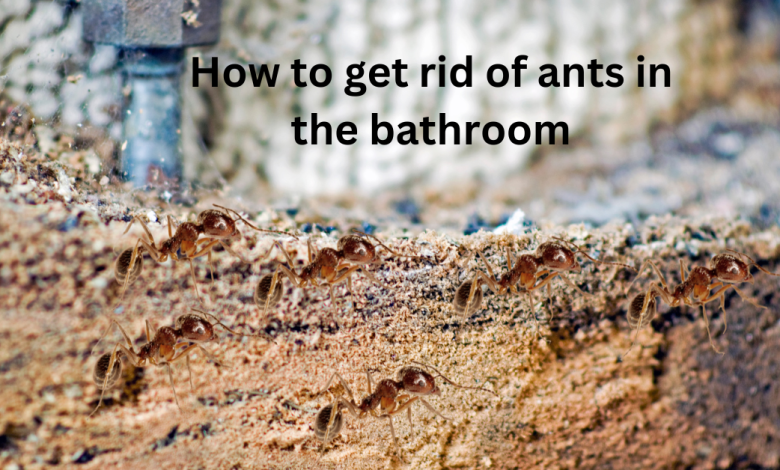How to get rid of ants in the bathroom

1. Start by sealing up any cracks or crevices in your bathroom, including around wall fixtures and baseboards. This will help prevent ants from getting inside the room. 2. Use a vacuum cleaner to suck up any visible ants, as well as their trails and nests that you can spot. Be sure to discard the vacuum bag immediately after use so the ants don’t get back into your house. 3. Wash down all of your surfaces with warm water and dish soap to remove any ant trails they may have left behind while searching for food sources in your bathroom. 4. Spray an insecticide around the edges of windowsills, baseboards, door frames, plumbing fixtures and other areas where you think there may be ant activity present or likely entry points for these creatures into your home. Make sure it is labeled safe for indoor use before spraying it inside your bathroom space! 5 . Place some ant bait traps near possible entry points like drains or vents where ants might sneak in through small gaps; this will attract them away from other places within the house instead of just killing them off right away when sprayed with an insecticide solution directly on contact
How to get rid of ants in the bathroom and kitchen
- Clean the bathroom: Start by thoroughly cleaning the bathroom, including all surfaces, floors and crevices where ants can hide
- Pay special attention to areas around sinks, toilets and showers as these are prime spots for ant infestations
- Seal any cracks or holes: Check for any small cracks in walls or along baseboards that may be used as an entry point for ants into your bathroom
- Use caulk to seal them up if possible so the ants cannot get through
- Remove food sources: Ants are attracted to moisture and food particles that may linger on countertops or other areas of your bathroom after use, so make sure to keep it clean at all times! Vacuum up any stray crumbs from snacks you’ve eaten recently or spilled liquid that could attract more pests in the future
- 4 Set out ant traps: Place ant bait traps near potential entry points such as windowsills or doorways leading into the room – this will help catch some of those sneaky bugs before they enter! Make sure not to place too many of these traps around since overdoing it could cause confusion among different species of ants which can lead them elsewhere instead of eliminating their presence altogether from your home entirely
Black Ants in Bathroom Meaning
Black ants in the bathroom can be a sign of an infestation, as they typically nest close to water sources. If you find them, it’s important to take steps to rid your home of the insects before they cause more damage or spread disease. To do this, use store-bought insecticides and cleaning products that are designed specifically for ant control. Additionally, sealing off potential entry points with caulk and other materials can help keep them from returning.
Vinegar for Ants in Bathroom
Vinegar is a great DIY solution for controlling ants in your bathroom. Not only does it kill existing ants, but it also deters future ant invasions by masking their trails. To use vinegar against these pests, mix equal parts white vinegar and water in a spray bottle and apply directly to the affected area. Be sure to get into all of the nooks and crannies that ants might be using as entry points or hiding spots. Additionally, you can pour undiluted white vinegar down drains to keep them free of pesky intruders.
Ants Coming Out of Bathtub Drain
Ants coming out of a bathtub drain is not an uncommon experience. It’s usually caused by moisture-loving ants that are attracted to the damp environment within the pipes in your home. Ants can enter through small cracks and crevices, seeking out sources of water, food and shelter. If you’re seeing ants coming from your drain it might be time for a thorough inspection of your plumbing system to identify any entry points they may have used.
Why are There Ants in My Bathroom in the Winter
When the weather outside is cold, ants may seek refuge indoors. They are attracted to bathrooms in particular due to their humidity and warmth. Ants can enter through even the smallest cracks or crevices around windowsills, doors or pipes, so it’s important to make sure your bathroom is properly sealed against these intruders. Additionally, you should also clean up any spills and food crumbs as they will attract them as well!
Tiny Black Ants in Bathroom And Kitchen
Tiny black ants in the bathroom and kitchen can be a nuisance. These ants are often attracted to moisture, sugary substances, and food crumbs that have been left behind. To get rid of them, it’s important to identify their entry points and seal off any potential gaps or cracks around windowsills, baseboards, doorways or pipes. Additionally, keeping countertops clean of food particles as well as wiping up spills right away can help prevent these pests from invading your home.
What Causes Ants in the Bathroom?
Ants in the bathroom can be a worrying occurrence, as they often suggest an invasion of unwanted pests. The most common cause of ants in the bathroom is moisture and food sources that attract them. Ants are attracted to sweeteners such as sugar, honey, syrup or even fruit juice spills. Any type of food residue left on countertops or floors will also draw ants into your home. In addition to these sources, small leaks around sink fixtures may create damp areas ideal for ant colonies to thrive on. Lastly, holes or cracks around windows and doors can provide easy entry points for ants from outside sources like gardens and yards where ant colonies live naturally. To prevent future infestations it’s important to keep your bathroom clean by wiping down surfaces regularly with soap and water; keeping all food off counters; sealing any cracks or holes near doorways; repairing any plumbing issues causing leaks; and using insecticides when necessary if you find yourself dealing with an infestation despite your best efforts at prevention. You will be able to control rodent infestation with ants.
What Kills Tiny Ants in Bathroom?
Tiny ants in the bathroom can be a huge headache to get rid of. They may seem small and harmless, but these pests can quickly multiply and become an annoyance. Fortunately, there are several ways to get rid of them without having to use chemical pesticides or other hazardous materials. The most effective way to kill tiny ants in the bathroom is by using baits or traps. These baits contain a sweet substance that attracts the ants, which then take it back to their colony where they feed on it, eventually killing off all of the ants within days. Alternatively, you could also try spraying vinegar directly on ant trails as this will repel them from coming back again soon after cleaning up any food sources that might have attracted them in the first place. Finally, if all else fails you can always contact a professional exterminator who can properly identify and eliminate whatever type of ant infestation you have in your home safely and effectively.
Can Ants Come Up Through Bathroom Drains?
It is quite common for people to be concerned about the possibility of ants coming up through bathroom drains. After all, it’s not exactly a pleasant thought to have tiny insects crawling around in your sink or bathtub! Fortunately, while it is possible for ants to enter bathrooms through drains, it isn’t very likely. In most cases, an ant will only make its way into a bathroom if there is an existing crack or hole in the piping that provides an easy access point. Additionally, some species of ants are attracted to moisture and may be drawn towards bathrooms due to high humidity levels caused by showers and baths. However, these types of infestations can usually be eliminated with proper cleaning procedures such as regularly wiping down surfaces with disinfectants and sealing any gaps between pipes where they meet walls or floors. If you’re still worried about having ants in your bathroom drains then consider using insecticides specifically designed for this purpose – just remember to follow the instructions carefully so as not to cause harm yourself or those living in the home!
What are the Little Tiny Ants in My Bathroom?
There are a variety of tiny ants that can invade your bathroom. These include pavement ants, small carpenter ants, and odorous house ants. Pavement ants are one of the most common types of ant found in bathrooms and they’re usually dark brown or black in color. They also have six legs per body segment and two antennae on their heads. Small carpenter ants are another type of ant commonly seen in bathrooms and they tend to be larger than pavement ants with a reddish-brown coloration. Finally, odorous house ants are smaller than both pavement and carpenter species but they give off an unpleasant smell when crushed between your fingers—hence their name! If you suspect you may have an infestation of these little critters, it’s best to contact a professional pest control service as soon as possible so they can identify the exact type of ant, determine how extensive the problem is, and come up with a plan for eradication before the problem gets any worse!
Conclusion
By following these simple steps, you can easily get rid of ants in the bathroom. The best way to prevent them from coming back is to make sure that all food and moisture sources are eliminated. This will create an environment where ants cannot survive or reproduce, ensuring your bathroom stays ant-free for a long time. With some routine maintenance and cleaning, you can keep those pesky critters away from your home for good!
Read Also: Fornez.com
We welcome the readers to write for us



